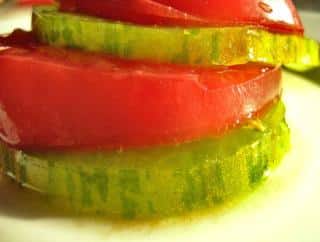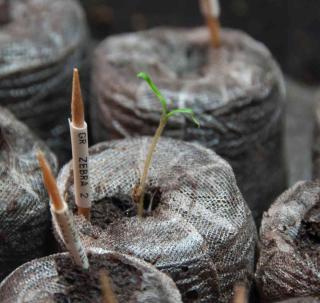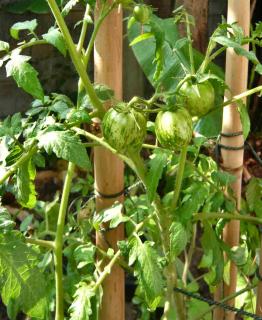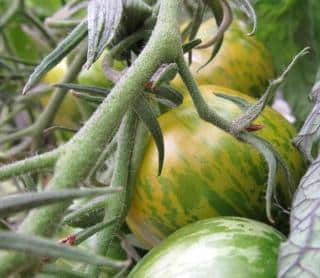

These turn gardeners crazy during harvest time with their green color that just stays green! ‘Green Zebra’ tomatoes add a welcome touch of something different in the vegetable patch, and in the plate, too!
Discover how to grow this charming and unique variety.
Read also:
Its fruits are round, average sized at a little over 3 ounces (90 g). The plants itself grows quite tall, about 6 feet (180 cm) when fully grown. The skin of the tomatoes is smooth, and the base color is greenish-yellow with darker green stripes. When sliced in half, the flesh is bright green, a flashy neon green color. Within the flesh are a few seeds and lots of juice which will make for a refreshing taste.
 This variety is often qualified as follows: juicy, sweet and with a tangy touch. This balance of flavor makes it a truly memorable experience. It pairs very well with other meaty tomatoes such as the ‘Beefsteak’ tomato. You’ll be deliciously surprised by its taste when cooking it as a gaspacho, jam, sauce and pie. Of course, it definitely deserves the honors of savoring it fresh from the garden, too: it’ll add a nice touch of green to your tomato salad.
This variety is often qualified as follows: juicy, sweet and with a tangy touch. This balance of flavor makes it a truly memorable experience. It pairs very well with other meaty tomatoes such as the ‘Beefsteak’ tomato. You’ll be deliciously surprised by its taste when cooking it as a gaspacho, jam, sauce and pie. Of course, it definitely deserves the honors of savoring it fresh from the garden, too: it’ll add a nice touch of green to your tomato salad.
This variety loves the sun, just like other tomato varieties. As for the soil, your best bet is rich substrate that’ll give the plant all the nutrients it needs to produce those much awaited fruits. Before the plant, remember to schedule a work session where you amend the soil with compost.
 If you’ve purchased young seedlings in nursery pots, transplant them to the ground starting in mid-April, once any risk of freezing is passed. Same thing for sowing directly in the ground: wait for freezing to have subsided. You can start seedlings in trays under cover as early as February. As soon as the seedlings have grown a few leaves, switch them out to individual nursery pots. Mid-April is when they’re due to transfer to the growing bed.
If you’ve purchased young seedlings in nursery pots, transplant them to the ground starting in mid-April, once any risk of freezing is passed. Same thing for sowing directly in the ground: wait for freezing to have subsided. You can start seedlings in trays under cover as early as February. As soon as the seedlings have grown a few leaves, switch them out to individual nursery pots. Mid-April is when they’re due to transfer to the growing bed.
 This tomato needs a substrate that stays cool and moist, but not soggy. This means it shouldn’t dry out completely between two watering sessions. During the hot season, water daily or every two days – that’s how much it needs water. Of course, if it has rained, no need to water on top of that. What you can also do is add a layer of mulch to lock moisture in and stop weeds from sprouting.
This tomato needs a substrate that stays cool and moist, but not soggy. This means it shouldn’t dry out completely between two watering sessions. During the hot season, water daily or every two days – that’s how much it needs water. Of course, if it has rained, no need to water on top of that. What you can also do is add a layer of mulch to lock moisture in and stop weeds from sprouting.
A good tip to keep the water supply up even when you’re out for the week-end: fill a bottle with water and flip it up-side down, burying the neck in the soil. Keep the cap on the bottle, but drill or pierce a few small holes in it. Water will drip through slowly, very much like a drip-irrigation system.
→ Tomato plant care: watering, fertilizer, pruning guide
Remember to water your plant at its base: don’t shower it all over. A consequence of getting the leaves wet is that wet leaves are prone to fungal diseases such as downy mildew. Also remove leaves that touch the ground, this helps reduce the moist air “oasis” effect. As for the pruning, remember to remove suckers as they emerge. These are small stems pop out at the junction of secondary and main stems.
 How can we tell it’s ripe, since it stays green? Touch is the sense you have to use to determine whether a fruit is ripe or not. Once it’s ripe, it’s soft when you press it with your finger; it also easily breaks off from its stem. Harvest typically takes place between July and October, 4 to 5 months after sowing.
How can we tell it’s ripe, since it stays green? Touch is the sense you have to use to determine whether a fruit is ripe or not. Once it’s ripe, it’s soft when you press it with your finger; it also easily breaks off from its stem. Harvest typically takes place between July and October, 4 to 5 months after sowing.